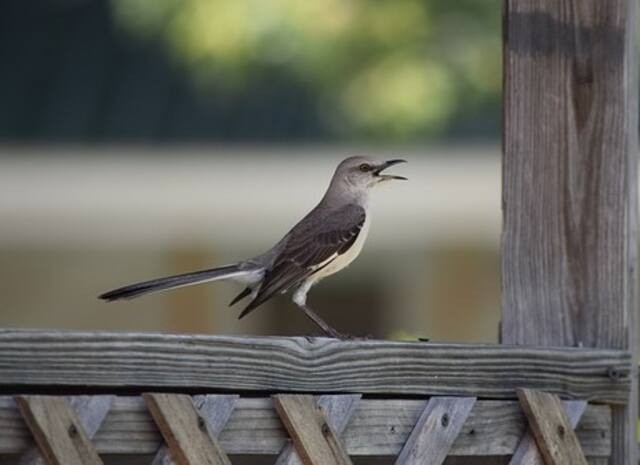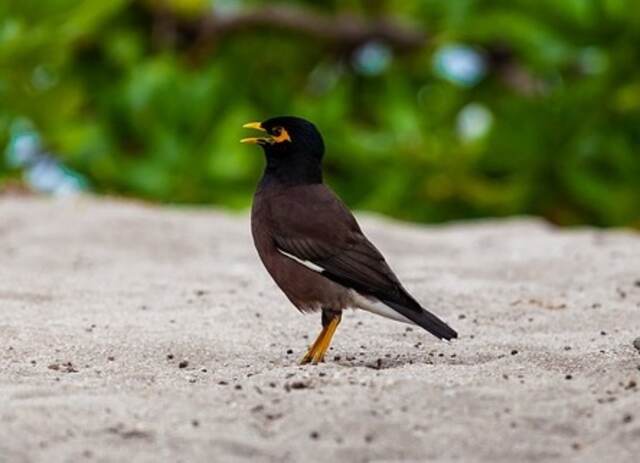Birds are one of the most interesting creatures in the world, and their ability to imitate sounds is especially fascinating. Whether it be a simple chirp, a complex song or even human words, birds have an innate ability to mimic many different sounds they hear around them. But why do birds imitate sounds? In this article, we will explore the reasons why birds copy other noises and what purpose this serves for them.
Table of Contents
- 1 Why Do Birds Imitate Sounds?
- 1.1 Birds Mimic Sounds as a Survival Mechanism
- 1.2 Birds Imitate Sounds to Find a Mate
- 1.3 Birds Mimic Sounds to Establish Territory
- 1.4 Birds Imitate Sounds for Communication
- 1.5 Birds Mimic Sounds when Danger is Approaching
- 1.6 Birds Imitate Sounds To Identify their own Species
- 1.7 Which Birds can Imitate Sounds?
- 2 Frequently Asked Questions
- 2.1 What backyard bird makes 50 different noises?
- 2.2 What birds can the crow imitate in sound?
- 2.3 What small bird can imitate any sound?
- 2.4 How do birds imitate sounds?
- 2.5 Why do birds imitate human sounds?
- 2.6 How are birds so good at imitating sounds?
- 2.7 Why do birds repeat what you say?
- 2.8 Do talking birds understand what they are saying?
- 2.9 Do birds respond to human singing?
- 2.10 Which bird can copy human voice?
- 2.11 What bird is the best mimic?
- 3 Author
Why Do Birds Imitate Sounds?
Birds Mimic Sounds as a Survival Mechanism
Birds will often mimic sounds because it’s a survival mechanism and the best way for them to survive is by being different from what their predators are used to hearing, which gives them an advantage in life.
Birds can also mimic sounds they hear during early life; this enables them to call out warning signals if there’s danger nearby. It might be useful for younger birds still learning how to fly, but older birds
Birds Imitate Sounds to Find a Mate
The ability to mimic sounds is one of the most important skills for any bird. It can mean the difference between attracting a mate or not, and it’s something that only certain species are able to do. It seems like some birds may have figured out how they can use this skill in order to attract mates.
Researchers recently discovered that some species of bird are able to mimic the call of another species in order to attract mates for themselves. This is a form of flirting and signaling to mates that they are ready for breeding.
Birds Mimic Sounds to Establish Territory
A new study by a team of Japanese researchers has revealed that some bird species mimic other sounds to establish territory. The sound-producing abilities in the brain’s auditory cortex are key to how this happens, they said.
Scientists have known for decades that birds can imitate sounds from their environment. However, the purpose behind this practice has not been entirely clear up until now.
In particular, scientists were not sure if imitation was simply done for entertainment or whether it served a practical function like establishing territory.
Birds Imitate Sounds for Communication
In a recent study published in the journal Animal Behavior, scientists have found that birds imitate sounds as an important way to communicate with other members of their species.
Birds use vocal imitation to share information about predators and location of food sources; this aids in cooperation among themselves, like when one bird alerts others by mimicking the sound of a predator they both hear.
Imitation is also used to form partnerships with unrelated members or potential mates: if another bird responds vocally back after hearing a call, the first bird can assume it’s a partner.
Birds Mimic Sounds when Danger is Approaching
A study published in Current Biology shows that birds imitate sounds from the environment to warn of danger, so they can fly away quickly if threatened by an approaching predator. Birds mimic sounds from the environment, such as alarm calls and distress signals.
They do this to avoid being preyed on because predators cannot tell what kind of bird is making a sound without seeing it. So when a bird hears another animal’s call for help, it copies it and flies away quickly.

Birds Imitate Sounds To Identify their own Species
Birds mimic sounds to identify their own species. This helps them identify who their own species is, and tells other bird species not to come in the territory.
This process is called vocal learning and there are two types of it: song imitation or call imitation. These vocalizations help birds with social interactions within their own flock or group.
There have been a few experiments where researchers played different calls for individual birds, and they reacted differently depending on what sound was played.
Which Birds can Imitate Sounds?
- Northern Mockingbird
- Steller’s Jay
- Blue Jay
- Lawrence’s thrush
- American Crow
- Phainopepla
- Eurasian Jay
- European Starling
- Gray Catbird
- Brown Thrasher
- Marsh Warbler
- Common Raven
Frequently Asked Questions
What backyard bird makes 50 different noises?
Every bird species has its own unique song, but did you know that one backyard bird is capable of making up to 50 different noises? The Northern Mockingbird is the only bird that can make so many sounds.
This incredible creature has an extensive repertoire of songs, including chirps, whistles, trills and even mimicry. It can imitate the sounds of other birds and animals, as well as mechanical noises like car alarms or wind chimes.
What birds can the crow imitate in sound?
Crows are some of the most recognizable birds in the world, but they can also be surprisingly talented mimics. Not only can crows imitate other bird calls, but they can accurately replicate the sounds of many different species. It has been observed that crows are capable of imitating cardinals, jays, titmice and wrens among others.
What small bird can imitate any sound?
The lyrebird is a small, ground-dwelling bird native to Australia that has an incredible ability to mimic sounds – it can imitate any sound it hears. The lyrebird’s remarkable voice is composed of its own songs, calls and mimicked sounds like those of other birds, animals, or even human voices and machines!
The lyrebird is able to accurately replicate the exact sound of another bird, animal or even mechanical items like car alarms or cellphones.
How do birds imitate sounds?
It turns out that birds have a range of methods for copying and creating new vocalizations that mimic those heard from other animals or even human speech. Birds use their syrinx, the vocal organ found at the base of a bird’s trachea, to create sound by vibrating air.
This is similar to how humans produce sound with their larynx and vocal cords. The unique structure of the syrinx allows some species of birds to generate highly complex noises that they can use as part of their calls or songs.
Certain species also have specialized muscles around the syrinx which enable them to adjust pitch, volume and tone while making sound.
Why do birds imitate human sounds?
Experts believe that mimicry is a way for birds to socialize and bond with their human companions. They may also imitate other animals in the wild, such as frogs and insects. By repeating these noises, they are able to communicate with others of their species and establish a hierarchy among themselves.
In addition, by learning how to mimic different voices and sounds, birds can gain acceptance from members of their flock or family unit. Surprisingly, some studies have even suggested that birds can recognize when particular noises are coming from humans versus other animals or sources!
How are birds so good at imitating sounds?
A bird’s ability to imitate sound is based on both their anatomy and behavior. A bird has a syrinx located near their vocal cords which produces sound when air passes through it, in combination with muscles located in and around the syrinx controlling pressure and tone.
This allows them to create more complex songs compared to other animals like frogs, by creating high-pitched tones and interweaving them together into more elaborate melodies.
Furthermore, birds learn how to mimic new sounds through listening, practice, trial-and-error or even outright copying another bird’s song.
Why do birds repeat what you say?
Birds are known for their ability to imitate sounds and words. This behavior, called parroting, is an interesting phenomenon in which birds mimic the sounds made by their environment. Parroting has been documented in many species of birds, from parakeets to ravens.
So why do birds repeat what you say? Parroting is thought to be a form of social behavior that helps build connection between two individuals or groups of animals. Many experts believe that these birds use mimicry as a way to communicate with each other and strengthen social bonds within the flock.
It’s also believed that this behavior helps attract mates, as it indicates intelligence and strength within the flock, while providing amusement for onlookers. Furthermore, parroting can help young birds learn new sounds more quickly than they would otherwise by mimicking their elders.
Do talking birds understand what they are saying?
While some birds such as parrots have an impressive verbal repertoire that takes years to perfect, it’s unlikely they understand more than a few words they hear.
Parrots are social animals and are capable of copying sounds in order to mimic their owners and other animals. Unfortunately, this does not necessarily mean they comprehend the meaning behind those words or phrases.

Do birds respond to human singing?
Do birds recognize, appreciate, and even respond to the music created by humans? Recent studies suggest that the answer may be yes. Researchers have discovered that some species of birds will actually sing along with a particular melody or tune when they hear it.
This behavior is seen most often in songbirds such as warblers, thrushes and wrens. Some species of parrots (such as budgerigars) have also been observed mimicking human voices.
The extent to which these birds understand and enjoy the experience varies from one species to another; however, many birds seem to be able to recognize familiar tunes and are capable of actively engaging in musical activities.
Which bird can copy human voice?
Surprisingly, there are quite a few species that are capable of repeating words and phrases they hear from humans. The most popular mimic is undoubtedly the parrot. These tropical beauties possess an impressive skill for imitating not only our voices, but also other sounds like car horns or telephone rings.
Other birds such as mockingbirds, crows, ravens and magpies are also known for their vocal skills; however, these species usually mimic more distant relatives such as other birds. Interestingly enough, myna birds can even combine two different kinds of noises to create original calls!
What bird is the best mimic?
The Indian myna often tops the list when it comes to mimicry skills. Native to Asia and Australia, this small songbird is known as one of nature’s greatest impressionists for its uncanny ability to imitate not only other bird calls but also various human voices, including specific people. It has even been observed that some Indian mynas can learn songs from domestic pets like cats and dogs!
Related Post: Do Birds Have Feelings and Emotions? (A Closer Look!)





